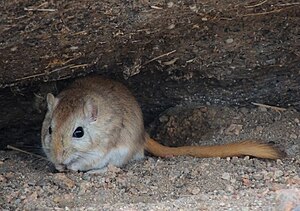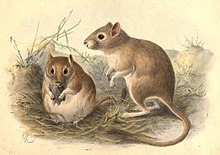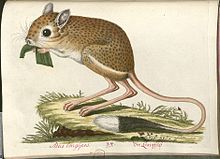Lunchtime rat
| Lunchtime rat | ||||||||||||
|---|---|---|---|---|---|---|---|---|---|---|---|---|

Midday rat ( Meriones meridianus ) |
||||||||||||
| Systematics | ||||||||||||
|
||||||||||||
| Scientific name | ||||||||||||
| Meriones meridianus | ||||||||||||
| ( Pallas , 1773) |
The midday gerbil ( Meriones meridianus ), also gerbil, is a rodent species from the genus of the racing rats ( Meriones ) within the gerbils (Gerbillinae). It is common in arid regions over large parts of Asia.
features
The midday racing rat reaches a head-trunk length of 9.5 to 13.4 centimeters with a tail of 8.4 to 12.0 centimeters in length . The rear foot length is about 25 to 34 millimeters, the ear length 10 to 19 millimeters. It is accordingly a medium-sized species of the genus, it is smaller than the Libyan racing rat ( M. libycus ) and the tamarisk racing rat ( Meriones tamariscinus ). The fur on the back is light gray-brown, gray-brown or dark brown, the hair has a gray-brown base. The peritoneum is woolly and colored white, there is a narrow brown stripe on the chest. The hind feet are densely hairy with reddish hair, the soles have no bare parts and the toes have white claws. The length of the tail corresponds approximately to the length of the head and trunk, it is pale to ocher-brown on the top and a little lighter on the underside.
The skull has a total length of 31 to 36 millimeters. The tympanic bladder (bulla tympanica) is very large, reaching 33% of the total length of the skull. The bone ridge above the eyes (supraoribal ridge) is usually only weakly developed in this species. The window of the palatine bone is long.
distribution
The midday racing rat is common over large parts of Asia. The distribution area extends from northeast Iran and the west of the Caspian Sea in Russia via Kazakhstan , Afghanistan , Kyrgyzstan , Tajikistan , Turkmenistan , Uzbekistan to the west and south of Mongolia and the north of the People's Republic of China . In China, the distribution area includes large parts of Xinjiang , Gansu , Qinghai , Shanxi , Shaanxi , Hebei , Nei Mongol and Ningxia .
Way of life
The midday rat lives in arid areas and sandy deserts and is adapted accordingly to life in extreme drought. It prefers hilly and bushy regions with thorn bushes as the predominant vegetation and occurs in sandy habitats of different soil stability, whereby it also inhabits fragmented sand landscapes and drift sand areas as well as sand areas of the steppes in the west of the distribution area. In contrast to the Mongolian racing rat ( Meriones unguiculatus ), the animals are mainly nocturnal, only in autumn and winter they are also active during the day (in contrast to their common name, whose origin is unknown). It lives socially and forms colonies, the animals create simple to complex structures in the area of the bushes and below the vegetation. The winter burrows can be up to two meters deep and the lengths are up to four meters. The diet of the midday rat is primarily herbivorous and the diet consists of seeds, fruits and, more rarely, leaves of the desert vegetation and also insects. She stores parts of the food in the building, but the total amount of these stocks is comparatively small and amounts to around 800 grams.
The reproductive activity takes place throughout the year. The intensity and temporal variance varies regionally depending on the local climate and differs significantly for populations in the south of the distribution area from those in the north. In the south, the activity begins in February to March and extends into October and, under optimal conditions, can cover the whole year, in the north it extends from April to September with two maxima in spring and autumn, but increases in summer and winter significantly or comes to a standstill. The young females give birth once or twice a year, after a year up to three times a year. The number of young animals per litter ranges from one to twelve and averages six.
The population densities are usually comparatively high and can be subject to large regional and temporal fluctuations. Depending on winter conditions and the availability of food, these fluctuations can vary by a factor of 10 or more. Like other gerbils, the midday rat is a potential carrier of the plague bacterium ( Yersinia pestis ), and populations are monitored accordingly.
Systematics
The midday rat is often classified as an independent species within the racing rats ( Meriones ), which consists of about 20 species. The first scientific description comes from the German naturalist Peter Simon Pallas, who described the species in 1773 using individuals from the Astrakhan Oblast in southeastern Russia. It is assigned to the subgenus Pallasiomys . The midday rat is sometimes viewed as a species complex of several species, but in some cases species that are already considered to be independent, such as the Cheng racing rat ( Meriones chengi ), are again synonymous with the midday rat on the basis of molecular biological studies . The Armenian racing rat ( Meriones dahli ) is also seen partly as an independent species and partly as a synonym of the midday racing rat .
Status, threat and protection
The midday rat is classified by the International Union for Conservation of Nature and Natural Resources (IUCN) as not endangered (least concern). This is justified with the very large distribution area and the frequent occurrence of the species. There are no potential threats to the species.
supporting documents
- ↑ a b c d e f Darrin Lunde, Andrew T. Smith: Mid-Day Gerbil. In: Andrew T. Smith , Yan Xie: A Guide to the Mammals of China. Princeton University Press, Princeton NJ 2008, ISBN 978-0-691-09984-2 , p. 250.
- ↑ a b c d e Meriones meridianus in the IUCN Red List of Threatened Species 2016.2. Posted by: N. Batsaikhan, K. Tsytsulina, N. Formozov, B. Sheftel, 2008. Retrieved November 19, 2016.
- ↑ a b Meriones (Pallasiomys) meridianus . In: Don E. Wilson , DeeAnn M. Reeder (Eds.): Mammal Species of the World. A taxonomic and geographic Reference. 2 volumes. 3. Edition. Johns Hopkins University Press, Baltimore MD 2005, ISBN 0-8018-8221-4 .
- ↑ Mamoru Ito, Wei Jiang, Jun J. Sato, Qiang Zhen, Wei Jiao, Kazuo Goto, Hiroshi Sato, Kenji Ishiwata, Yuzaburo Oku, June-Jie Chai, Haruo Kamiya: Molecular phylogeny of the subfamily Gerbillinae (Muridae, Rodentia) with emphasis on species living in the Xinjiang-Uygur Autonomous Region of China and based on the mitochondrial cytochrome b and cytochrome c oxidase subunit II genes . In: Zoological Science . tape 27 , no. 3 , 2010, p. 269-278 , doi : 10.2108 / zsj.27.269 .
- ^ Igor Jakowlewitsch Pawlinow: A review of phylogeny and classification of Gerbillinae (Mammalia: Rodentia) . In: Зоологические исследования . No. 9 , 2008, p. 1-68 .
- ↑ Ying Wang, Li-Ming Zhao, Feng-jie Fang, Ji-Cheng Liao, Nai-Fa Liu (2013): Intraspecific molecular phylogeny and phylogeography of the Meriones meridianus (Rodentia: Cricetidae) complex in northern China reflect the processes of desertification and the Tianshan Mountains uplift. Biological Journal of the Linnean Society 110: 362-383.
literature
- Darrin Lunde, Andrew T. Smith: Mid-Day Gerbil. In: Andrew T. Smith , Yan Xie: A Guide to the Mammals of China. Princeton University Press, Princeton NJ 2008, ISBN 978-0-691-09984-2 , p. 250.
Web links
- Meriones meridianus inthe IUCN Red List of Threatened Species 2016.2. Posted by: N. Batsaikhan, K. Tsytsulina, N. Formozov, B. Sheftel, 2008. Retrieved November 19, 2016.

